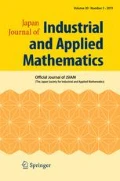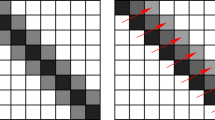Abstract
We consider the behavior of the dqds algorithm with Rutishauser’s shift for computing singular values of matrices. In our previous paper Aishima et al. (Jpn J Ind Appl Math 25:65–81, 2008), it has been proved that the algorithm asymptotically achieves cubic convergence; i.e., possibly after some “transient” period with seemingly random shift choices, the system finally reaches its final phase of convergence, where Rutishauser’s shift is chosen continuously and the convergence becomes cubic. In actual numerical examples, however, often the situation is far simpler. Once Rutishauser’s shift becomes valid, it is continuously chosen, and we find no such “transient” phase in practice. In this paper we give a theoretical explanation for the phenomenon, to fill the gap between the numerical observation and the theory.
Similar content being viewed by others
References
Aishima K., Matsuo T., Murota K.: Rigorous proof of cubic convergence for the dqds algorithm for singular values. Jpn. J. Ind. Appl. Math. 25, 65–81 (2008)
Aishima K., Matsuo T., Murota K., Sugihara M.: On convergence of the dqds algorithm for singular value computation. SIAM J. Matrix Anal. Appl. 30, 522–537 (2008)
Aishima K., Matsuo T., Murota K., Sugihara M.: Superquadratic convergence of DLASQ for computing matrix singular values. J. Comput. Appl. Math. 234, 1179–1187 (2010)
Aishima K., Matsuo T., Murota K., Sugihara M.: A survey on convergence theorems of the dqds algorithm for computing singular values. J. Math. Ind. 2, 1–11 (2010)
Aishima, K., Matsuo, T., Murota, K., Sugihara, M.: A shift strategy for superquadratic convergence in the dqds algorithm for singular values (submitted)
Anderson, E., Bai, Z., Bischof, C., Blackford, S., Demmel, J., Dongarra, J., Du Croz, J., Greenbaum, A., Hammarling, S., Mckenny, A., Sorensen, D.: LAPACK Users’ Guide, 3rd edn. SIAM, Philadelphia (1999)
Demmel, J.: Applied Numerical Linear Algebra. SIAM, Philadelphia (1997)
Dhillon, I.S.: A new O(n 2) algorithm for the symmetric tridiagonal eigenvalue/eigenvector problem, Ph. D thesis, Computer Science Division, University of California, Berkeley, California (1997)
Dhillon I.S., Parlett B.N.: Multiple representations to compute orthogonal eigenvectors of symmetric tridiagonal matrices. Linear Algebra Appl. 387, 1–28 (2004)
Dhillon I.S., Parlett B.N.: Orthogonal eigenvectors and relative gaps. SIAM J. Matrix Anal. Appl. 25, 858–899 (2004)
Fernando K.V., Parlett N.B.: Accurate singular values and differential qd algorithms. Numerische Mathematik. 67, 191–229 (1994)
Golub G.H., Van Loan C.F.: Matrix Computations, 3rd edn. Johns Hopkins University Press, Baltimore (1996)
Henrici P.: Applied and Computational Complex Analysis, vol. 1. Wiley, New York (1974)
Kimura, K., Takata, M., Tsuboi, H., Nakamura, Y.: Some lower bounds formulas of the smallest singular value. In: Proceedings of 2007 annual meeting of JSIAM, pp. 230–231 (in Japanese, 2007)
LAPACK, http://www.netlib.org/lapack/
Marques, O., Vömel, C., Demmel, J., Parlett, B.: Algorithm 880—a testing infrastructure for LAPACK’s symmetric eigensolvers, ACM Trans. Math. Softw. 35(8) (2008)
Parlett B.N.: The New qd algorithm. Acta Numerica. 4, 459–491 (1995)
Parlett, B.N.: The Symmetric Eigenvalue Problem. Prentice-Hall, Englewood Cliffs, New Jersey, 1980; SIAM, Philadelphia (1998)
Parlett B.N., Marques O.: An implementation of the dqds algorithm (positive case). Linear Algebra Appl. 309, 217–259 (2000)
Rutishauser H.: Über eine kubisch konvergente Variante der LR-Transformation. Zeitschrift für Angewandte Mathematik und Mechanik. 11, 49–54 (1960)
Wilkinson J.H.: The Algebraic Eigenvalue Problem. Clarendon Press, Oxford (1965)
Yamamoto, Y., Kimura, K., Nakamura, Y.: Asymptotic convergence analysis of various shifting strategies for singular value computation. In: Proceedings of 2007 annual meeting of JSIAM, pp. 136–137 (in Japanese, 2007)
Yamamoto, Y., Miyata, T.: On convergence of dqds algorithm that uses Ostrowski and Brauer type lower bounds as shifts, Trans. Jpn. Soc. Ind. Appl. Math. 18:107–134 (in Japanese, 2008)
Author information
Authors and Affiliations
Corresponding author
About this article
Cite this article
Aishima, K., Matsuo, T. & Murota, K. A note on the dqds algorithm with Rutishauser’s shift for singular values. Japan J. Indust. Appl. Math. 28, 251–262 (2011). https://doi.org/10.1007/s13160-011-0037-x
Received:
Revised:
Published:
Issue Date:
DOI: https://doi.org/10.1007/s13160-011-0037-x




